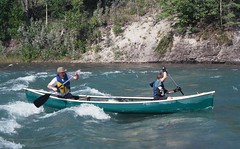Why Running a City is Like Paddling a Canoe
 Canadians are supposed to be good in a few things: skating, painting trees and rocks, welcoming newcomers, writing engaging stories that surely must have a meaning in there somewhere, and paddling a canoe. The canoe—a bit like the moose—holds an almost mythic place in the Canadian psyche. Anything and everything can be compared to canoeing. This metaphor is apt when applied to city administration.
Canadians are supposed to be good in a few things: skating, painting trees and rocks, welcoming newcomers, writing engaging stories that surely must have a meaning in there somewhere, and paddling a canoe. The canoe—a bit like the moose—holds an almost mythic place in the Canadian psyche. Anything and everything can be compared to canoeing. This metaphor is apt when applied to city administration.
An experienced and comfortable pair of paddlers can take a canoe almost anywhere and through whatever waves, winds and rapids that might arise. Over any sort of distance, solo kayakers with their fancy paddles and cramped storage compartments are no match for a canoe with tandem paddlers. Canoeing is the most efficient and gracious way to travel on open water—the secret to good canoeing, as with city administration, is good communication and a ‘little-little, big-big’ approach.
A canoe really doesn’t want to stay on a straight line. Wind and waves almost seem to have a mind of their own of where the canoe should go. So the person steering from the stern needs to adjust direction and momentum several strokes ahead. Small and steady course corrections keep you most closely to your desired route.
‘Five Cities Going Green: How Are They Doing It?’ was released last month by the Growth Dialogue. The book reviews the greening efforts of five exemplary cities (Curitiba, Helsinki, Penang, Ulsan, Yokohama). The ‘best in class’ efforts all had one thing in common: The improvements were incremental. Seemingly ‘little’ efforts steadily added together have a big impact.
Usually the person in the back of the canoe is the captain, deciding the direction of travel and steering with the ‘J-stroke’: just a little twist of the wrist at the end of the stroke to keep the canoe travelling in a straight line. Never crossing the paddle from side to side of the canoe to steer. The person in the front provides the steady power and sets the pace. This is ideal in navigating under normal conditions.
Of course city’s can hit rough patches and turbulent weather just as easily as canoes. Any good canoer knows that you should always scout out the rapids before you enter. But once you’re in the rapids, leadership changes and it’s the person in the front of the canoe that takes charge, shouting out—often in terror—‘draw’, ‘pry’ and pointing where they want to go. The person in the back uses their paddle mostly as a rudder, and might even offer a prayer if there’s time.
City leaders hope for calm seas. This enables them to focus on both the ‘little’ and ‘big’ things and ensures that the ship is heading in the right direction. However every city now and then finds itself in a tempest. This is when leadership, communication and the ability to refocus between the small and the large, short term and long term, matters even more; good planning; good communication; good scouting; and above all hang on and make sure you’ve got your life jacket on.
Photo source: Flickr Creative Commons, by "canoe too"
A canoe really doesn’t want to stay on a straight line. Wind and waves almost seem to have a mind of their own of where the canoe should go. So the person steering from the stern needs to adjust direction and momentum several strokes ahead. Small and steady course corrections keep you most closely to your desired route.
‘Five Cities Going Green: How Are They Doing It?’ was released last month by the Growth Dialogue. The book reviews the greening efforts of five exemplary cities (Curitiba, Helsinki, Penang, Ulsan, Yokohama). The ‘best in class’ efforts all had one thing in common: The improvements were incremental. Seemingly ‘little’ efforts steadily added together have a big impact.
Usually the person in the back of the canoe is the captain, deciding the direction of travel and steering with the ‘J-stroke’: just a little twist of the wrist at the end of the stroke to keep the canoe travelling in a straight line. Never crossing the paddle from side to side of the canoe to steer. The person in the front provides the steady power and sets the pace. This is ideal in navigating under normal conditions.
Of course city’s can hit rough patches and turbulent weather just as easily as canoes. Any good canoer knows that you should always scout out the rapids before you enter. But once you’re in the rapids, leadership changes and it’s the person in the front of the canoe that takes charge, shouting out—often in terror—‘draw’, ‘pry’ and pointing where they want to go. The person in the back uses their paddle mostly as a rudder, and might even offer a prayer if there’s time.
City leaders hope for calm seas. This enables them to focus on both the ‘little’ and ‘big’ things and ensures that the ship is heading in the right direction. However every city now and then finds itself in a tempest. This is when leadership, communication and the ability to refocus between the small and the large, short term and long term, matters even more; good planning; good communication; good scouting; and above all hang on and make sure you’ve got your life jacket on.
Photo source: Flickr Creative Commons, by "canoe too"
No comments:
Post a Comment